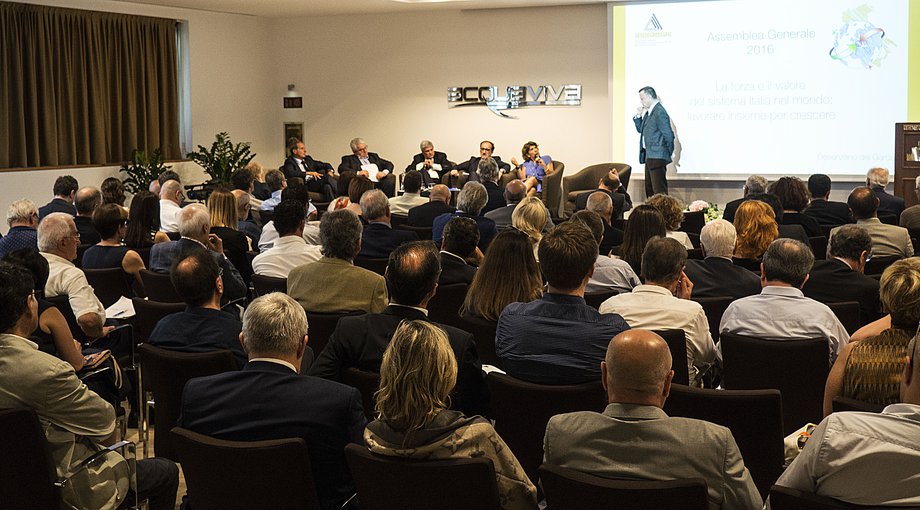The Annual Assomac Meeting brought together players from the leather fashion and footwear industries
A system on the move, sharing and seeking common ground and cooperation to tackle market challenges: this is the picture painted by the Annual Assomac Meeting attended by players from the leather fashion and footwear industries, who discussed and debated on "The strength and value of the Italian system worldwide: working together for growth".
"Maintaining a systematic approach is the challenge of the coming years; we must work together and as a system if we are to be competitive – said Assomac President Gabriella Marchioni Bocca. We represent a major sector and knowing this encourages us to remain united and act together at all levels. It is a difficult but not impossible task if we all keep looking in the same direction."
The Assomac President’s recommendation was picked up by Confindustria President Vincenzo Boccia who, at the end of the meeting, stressed that Italian companies must react to and not fight market challenges. The responsiveness comes also via cooperation and strong synergy on projects involving the whole production chain, developing strategic paths for the creation of a shared vision of the future and, above all, ways to best intercept market demands in advance. Our ultimate aim must be to work side by side on specific initiatives and pro-active and determined cooperation, recognising our potential and changing trade associations from dugouts to avant-gardes.
The sociologist Giuliano da Empoli focused on initial reactions to Brexit and how the result reflects the degree to which societies wish to gain more control of their destiny to respond to changes in the global context around us and then journalist Antonello Piroso moderated a debate also featuring MIPEL President Roberto Briccola, Cavaliere del Lavoro Giancarlo Dani, UNIC director Roberto Luongo, the director general of ICE Agenzia and Andrea Tomat, President of Lotto Sport Italia and Stonefly.
The debate firmly showed that acting as a team is extremely important today but, as MIPEL President Roberto Briccola also highlighted, we must make the most of our own brands and be able to manufacture a good product so as to continue being competitive, even in an evolving global context.
New technologies are key in this sense as is a fast corporate response to major issues of international interest such as sustainability and energy saving.
As was highlighted on several sides, productivity is the foundation of Italian companies’ competitiveness but Italy’s greatness lies in its efficiency and the ability to evolve from being manufacturers to entrepreneurs, becoming "big" while remaining "small ", partly via a visionary European policy that is also pragmatic, with simple and transparent regulations. We need an industrial policy that can help the system become a world leader via innovation and the entrepreneurs’ ability to adapt, as underscored by Andrea Tomat, President of Lotto Sport Italia and Stonefly.
A more international outlook came from Roberto Luongo – the director general of ICE Agenzia, who argued that taking advantage of each company’s strengths is not enough to remain globally competitive. We must focus on exports which are the real force of the Italian system and consolidate corporate presences abroad, with effective and lasting actions.
Equally crucial factors are training and generational turnover which exploit the historical and craft legacy that has made Italian companies international excellences. As also underscored by Cavaliere del Lavoro Giancarlo Dani, a UNIC director, it is crucial for companies to become more managerial and able to cope firmly with the market shock and a recession that is still being felt. We must, however, remain places where, every day, you can breathe the history that has made them great and the shared values that have made that brand an example of successful manufacturing.
The Meeting also offered an opportunity to present a snapshot of the sector which, after a more than positive two years, suffered a setback in 2015 with an overall production growth of just 1.93%. Although lower than the rate recorded in 2014, which was 9.56%, this represents more than twice the growth rate of the Italian economy.
Last year’s growth was primarily driven by exports – our real strength and the most important share of the turnover on the sector’s balance sheet – which rose for the third year running. Overall exports, including machinery for synthetic products and other machinery, recorded an increase of 2.28%, again lower than in previous years.
In terms of the destinations of the sector’s exports, we note that, after some years, Western Europe has resumed investments in technology for tanning, footwear and leather goods. In 2015, this market represented 15.15% of tanning machinery exports; 23.28% of footwear machinery exports and 40.94% of leather goods machinery exports.
Exports to Central/North America are also on the rise although this area lies in fifth place as an export destination for the leather/footwear machinery and so, although the growth rates are significant, they are sometimes linked to relatively small volumes.
